
CATALYST SPRING–SUMMER 2024. VOLUME 52. NUMBER 1 BR AN DY WI NE

CONSTRUCTION UPDATE
While we work to provide a better and more welcoming experience for all visitors, we continue to deeply appreciate your patience and understanding as construction projects continue around our campus and inside the Museum building. As we previously shared in the last issue of Catalyst, the renovations of our outdoor courtyard and the entrance walkway are both well underway and will be nearing completion this summer. We look forward to reopening the courtyard and seeing it come alive with educational programs and special events, as well as the greater accessibility this space will provide to all visitors with a new permanent ADA entrance ramp into the Museum's front doors.
Although the end result will be rewarding, the courtyard construction has had a disruptive impact on several operations and events, including the cancelation of this year's Wildflower, Native Plant, and Seed Sale (typically held each year over Mother's Day weekend). The sale will return in May 2025 and will be hosted in the newly renovated courtyard. In lieu of preparing for this year's native plant sale, Brandywine's dedicated garden staff and volunteers have been focusing their efforts on recovering and preserving as many native plants from around our campus as possible that are located in impacted construction areas. Their goal is to add as many of these rescued plants as possible back into our campus landscape once construction is complete.
Inside the Museum, a new accessible family restroom has been added to the first floor near the Millstone Café. Additionally, a state-of-the-art event space and classroom is now open on the Museum's second floor. Named the Waterview Room, this beautiful space was created out of former offices and features floor-to-ceiling windows overlooking the Brandywine Creek. It has already been a wonderful indoor area for lectures, art activities, and special events.
Learn more about all of these projects and more to come at www.brandywine.org/construction
An Inside Look at Brandywine Internships
Frank Stewart's Nexus
Beyond Conservation: A Look at Landowner Stewardship
Celebrating the Legacy of Kuerner Farm
Thinking Big Picture with Multi-Municipal Planning
Inside Every Leaf & Twig: Andrew Wyeth's Botanical Imagination
Announcing the new Andrew & Betsy Wyeth Study Center
Recent Acquisitions at the Brandywine
Events Calendar
Memorials & Tributes

Catalyst is published semi-annually by the Brandywine Conservancy & Museum of Art, a public charity founded in 1967. It is sent free to all members. Questions may be directed to Marketing & Communications, P.O. Box 141, Chadds Ford, PA 19317.
© 2024 Brandywine Conservancy & Museum of Art.
Brandywine Conservancy & Museum of Art is registered with the Commonwealth of Pennsylvania under the provision of Act No. 1990-202. Solicitation of Funds for Charitable Purposes Act. A copy of the official registration and financial information may be obtained from the Pennsylvania Department of State by calling toll-free, within PA (800) 732-0999. Registration does not imply endorsement.
4 5 6 10 14 18 20 23 24 26 31
Member Spotlight
IN THIS ISSUE: 100% recyclable This publication is printed on paper manufactured from 10% recycled fibers certified by the Forest Stewardship Council (FSC).
MEMBER SPOTLIGHT

The Fleischmann family have been members of the Brandywine Conservancy & Museum of Art for over 30 years. While they joined as official members in 1993— and later became inaugural members of the Conservancy Circle in 2023—they have a history and connection with the Brandywine that encapsulates a much longer and more varied story.
As a student at the University of Pennsylvania in the mid-1970s, Charlie Fleischmann started interning at the Brandywine when it was a fledgling organization dedicated to conservation. Less than a decade later, in the early 1980s, Blair found the Brandywine through her passion for conserving open space. When she learned the King Ranch property—the largest privately owned contiguous tract of land in Chester County—was at risk of being developed, she joined the fight to preserve all 5,367 acres from development.
The Fleischmanns found a common interest in fighting for open space and land conservation with the Brandywine. After getting married in 1992, they quickly became official members of the Brandywine Conservancy & Museum of Art and have since been involved in our different conservation efforts.
Charlie, a former horse racer, participates in our annual Radnor Hunt Races, where he serves as a Steward. For the last 44 years, the Radnor Hunt Races has been Racing for Open Space, raising funds and awareness for the Brandywine Conservancy’s open space and clean water programs. While Charlie helps at Radnor, Blair is a member of our Conservancy Committee. She believes it is essential to have a committee dedicated to bringing in new perspectives from all angles on land conservation.
When speaking about our organization, Charlie and Blair both found it difficult to pick their favorite Brandywine moment, but eventually settled on two. When they first purchased their farm in the area, Brandywine board member George Strawbridge was able to help them with the easement of some of the property next door, which originally was part of the same farm. Later, he helped them host meetings for their friends, neighbors, and other local residents, where together, Charlie, Blair, and George could teach their guests about the easement process and its importance to land conservation. On a more playful note, Charlie and Blair fondly remem-
bered Brandywine's co-founder George A. “Frolic” Weymouth making their son, Oliver, laugh when Frolic would attend events in fun costumes or participate in the “Tip-A-Canoe” event. Both Blair and Charlie credit their membership to the Brandywine to Frolic.
Blair believes her continued support of the Brandywine is due to the missions and values she has in common with the community. She shares how, like the Brandywine community, “it has always been apparent to us that preservation of the land was important.” Charlie and Blair continued to say that through the Brandywine community, and as members of the Conservancy Circle, they have been able to find like-minded individuals invested in making a difference. n
Want to share the spotlight? Contact our Membership department for details on how you can be featured in our next issue of Catalyst . Email us at membership@brandywine.org.
4
Left: Blair and Charlie Fleischmann
AN INSIDE LOOK AT BRANDYWINE INTERNSHIPS
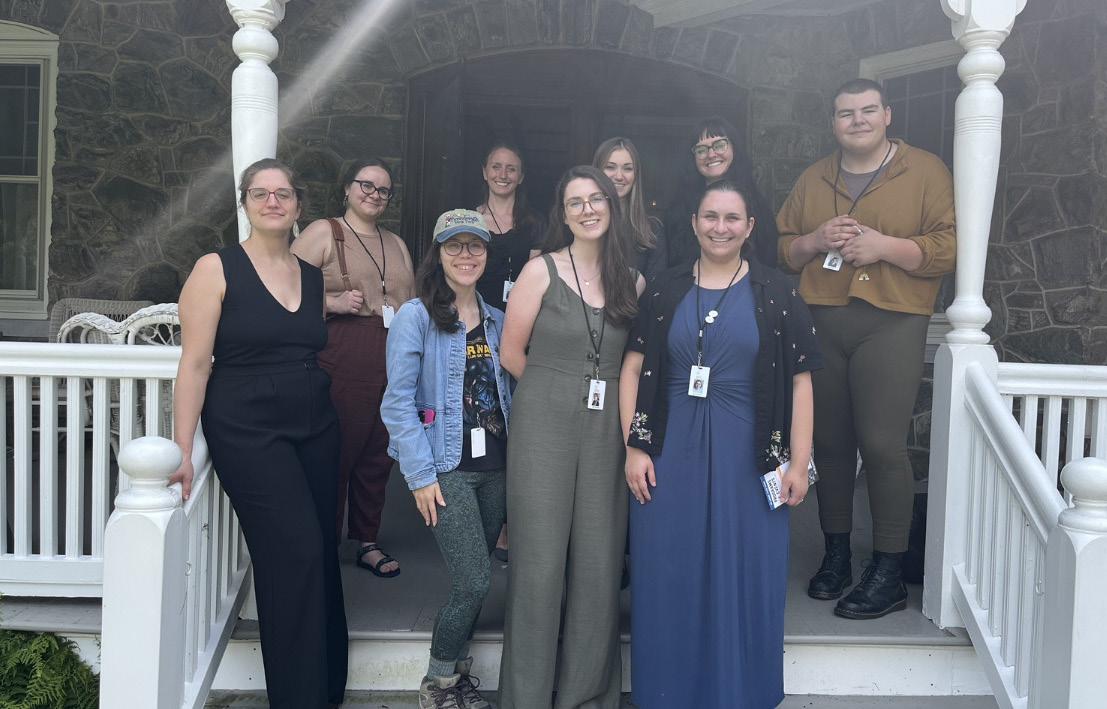
Last summer, a passionate cohort of interns from across the country came to work at the Brandywine Museum of Art. With a competitive stipend, networking field trips, and varied projects, internships at Brandywine offer a holistic museum experience for those interested in learning more about the arts and culture sector.
Olive Collinson, 2023 Curatorial Intern and part-time Brandywine security guard, shared that during her internship she felt surprised at her level of agency in the projects. She describes, “I loved sleuthing to find more information on Philadelphia-based artist and educator Allan Freelon for an upcoming exhibition, digging in newspaper archives and drafting paperwork. Setting up the gallery floor plan felt like a puzzle to solve.”
Like Collinson, other interns showcased their skills last summer with challenging projects. Education interns developed art activities for the Museum’s popular children’s
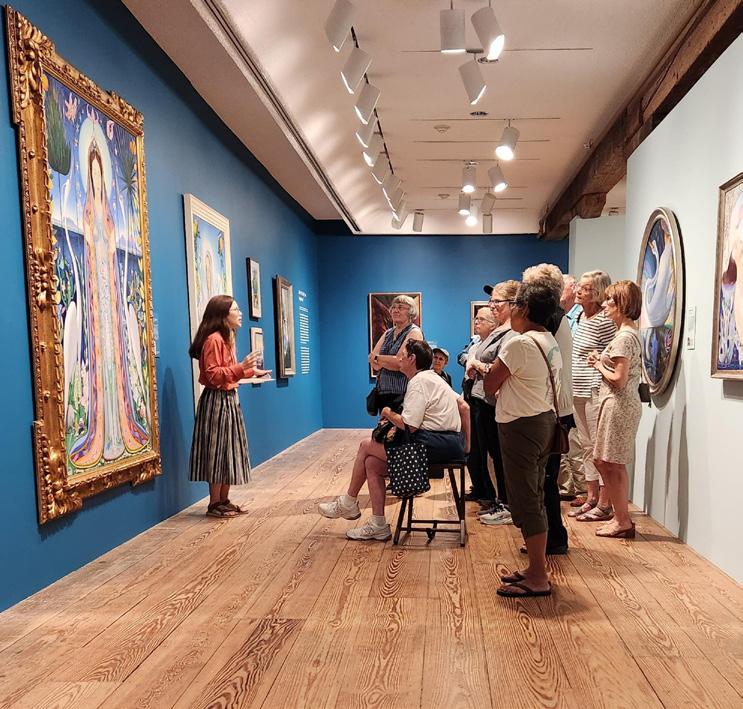
programs and led conversations with adult visitors in the galleries. Brandywine’s Graphic Design intern worked on a prototype “story walk” featuring a children’s picture book to be used by both Conservancy and Museum staff at family events. The Collections Management intern assisted with an inventory of the Museum’s works on paper.
Due to construction of the Wyeth Study Center on the second floor of the Museum, the Brandywine's Walter & Lenore Annenberg Research Center temporarily relocated upstairs. This major effort added to the experience of Research Center Intern Ava St. Pere, who shared, “I’ve come out of this experience with much better problem-solving skills than I would have during a typical internship. I had to learn to adjust my plans to the many surprises and changes that have arisen.” The practical learning opportunities interns experience at Brandywine helps prepare them for future roles in the museum field.
Curatorial, Collections Management, Education, Graphic Design, and Research Center internship positions are offered at the Museum annually, in addition to internships offered with the Brandywine Conservancy in Easement Stewardship and Land Management. Last summer, the applicant pool included 220 submissions from students from over 50 different universities. Brandywine seeks to continue diversifying its internship program through grassroots marketing for recruitment, collaborating with other cultural institutions in a Museum Internship cohort, and building community relationships.
With much gratitude for all the donors who help support this important program, we look forward to welcoming our Summer 2024 interns and the energy they will bring to Brandywine’s campus. n
Left to right: Summer 2023 interns
Intern Estrella Salgado leading an Art Chat program
5
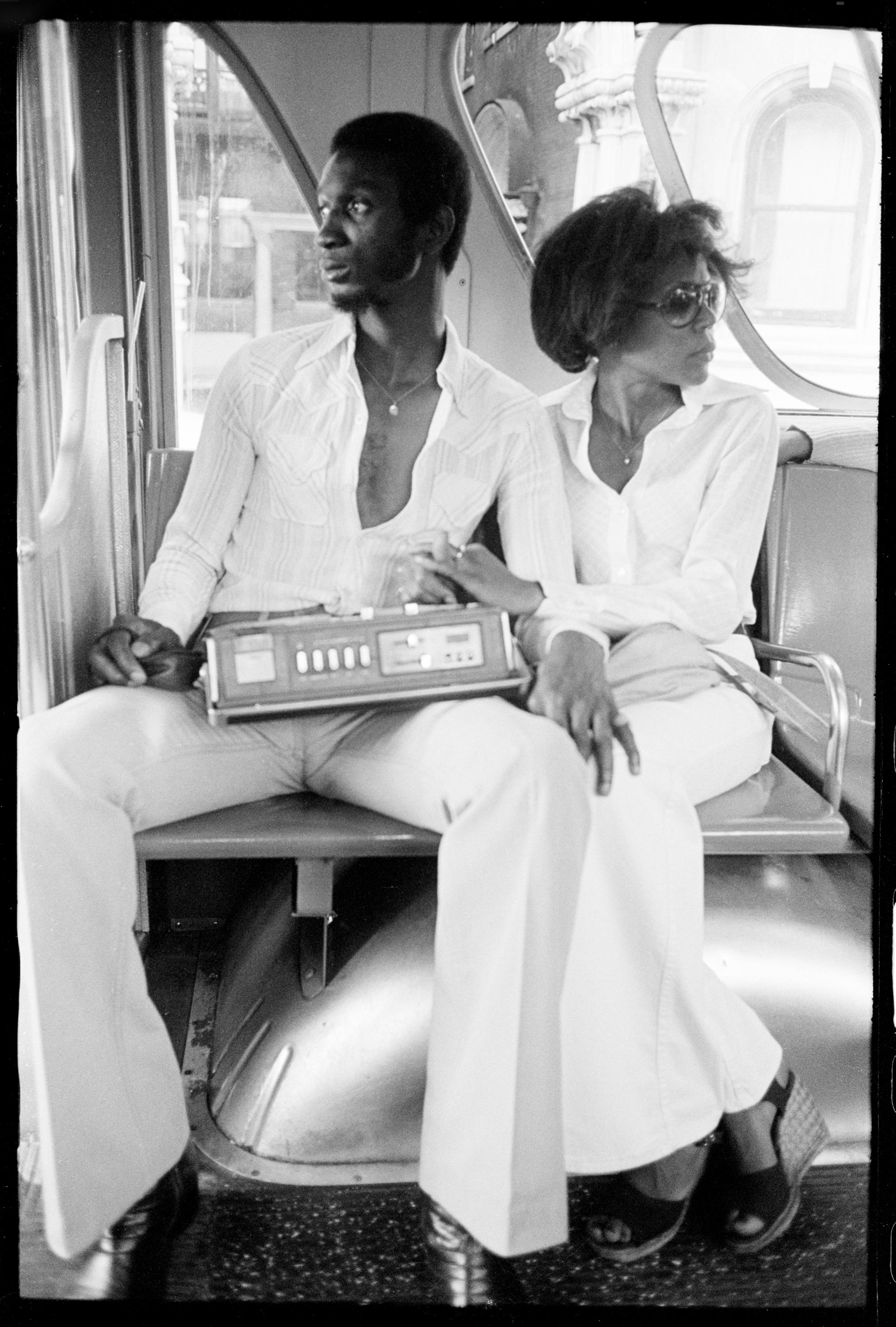
FRANK STEWART’S NEXUS: AN AMERICAN PHOTOGRAPHER’S JOURNEY, 1960S TO THE PRESENT
June
29–September 22, 2024
This summer, Brandywine Museum of Art will present Frank Stewart’s Nexus: An American Photographer’s Journey, 1960s to the Present. This dynamic retrospective of Stewart’s compelling photography centers on his sensitive and spontaneous approach to portraying world cultures and Black life in many forms—including music, art, travel, food, and dance—through over 100 black-andwhite and color photographs. Co-organized by The Phillips Collection (Washington, D.C.) and The Telfair Museums (Savannah, GA), this special exhibition highlights Stewart’s visionary work, which has captured intimate and empathetic images of lives experienced and observed across subjects, cities, and countries.
“With this exhibition, we have a chance to get a sense of the unlimited range and depth of a contemporary genius,” said Fred Moten, who co-curated the exhibition with Ruth Fine. “Frank Stewart’s combination of loving care for his subjects and thoughtful consideration of his medium is singular and invaluable.”
Organized into thematic groupings, Frank Stewart’s Nexus traces both his explorations of life on the road and the trajectory of his stylistic journey. Born in 1949, Stewart’s nomadic life and vision can be traced to his childhood, with his shifts back and forth from Memphis, Chicago, and New York. The earliest works in the exhibition were taken as a teenager photographing and documenting the 1963 March on Washington for Jobs and Freedom.

Frank Stewart’s Nexus will explore Stewart’s avid experimentation as he captured numerous subjects over the course of half a century. In addition to the many aspects and rituals of Black culture, his interest in world cultures is visible throughout his practice, particularly the impact of his many trips to Africa and Cuba over the years.
Music—gospel, blues, and jazz—is one of his overarching influences. Stewart traveled internationally with the Jazz at Lincoln Center Orchestra as their senior staff photographer from 1990–2020. Throughout his time with the orchestra, Stewart captured
Page 6:
Frank Stewart, Radio Players Series (or The Bus), 1978, gelatin silver print, 14 x 11 in. Collection of Sing Lathan and Bining Taylor
Above:
Frank Stewart, Self-portrait, Dominican Republic, 1986, gelatin silver print, 16 x 20 in. Collection of the artist
All photos © Frank Stewart
7


both public performances and candid, personal moments, creating an intimate portrait of some of the most celebrated musicians of our time. Stewart’s well-known photographs of jazz legends Miles Davis, Ahmad Jamal, and Wynton Marsalis are a highlight of the exhibition, on display with candid shots of other artists in their workplaces.
The exhibition also provides a window into less-explored aspects of Stewart's practice, including his works focused on environmental catastrophes, including the aftermath of Hurricane Katrina in New Orleans between 2005–07 and the devastating fires in California and the Pacific Northwest.
“This exhibition explores Stewart’s celebratory attitude to life, often with a touch of irony,” shares Ruth Fine. “The theme of intimate and subtle relations between and among people is essential to Stewart’s art. His responses to the human dilemma reflect his ability to gain trust from those with whom he interacts—both friends and strangers.” n This project is supported in part by the National Endowment for the Arts.

8
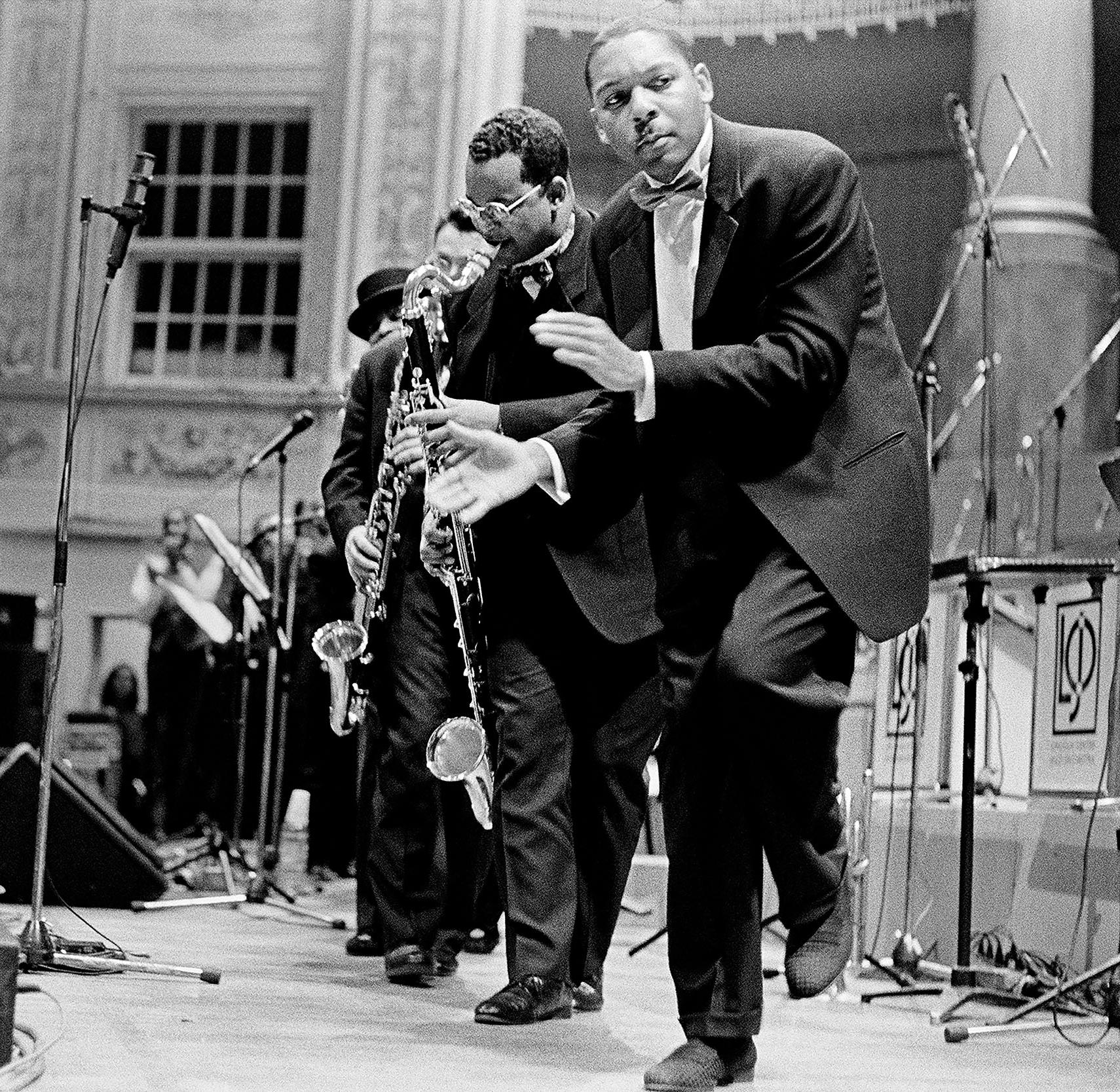
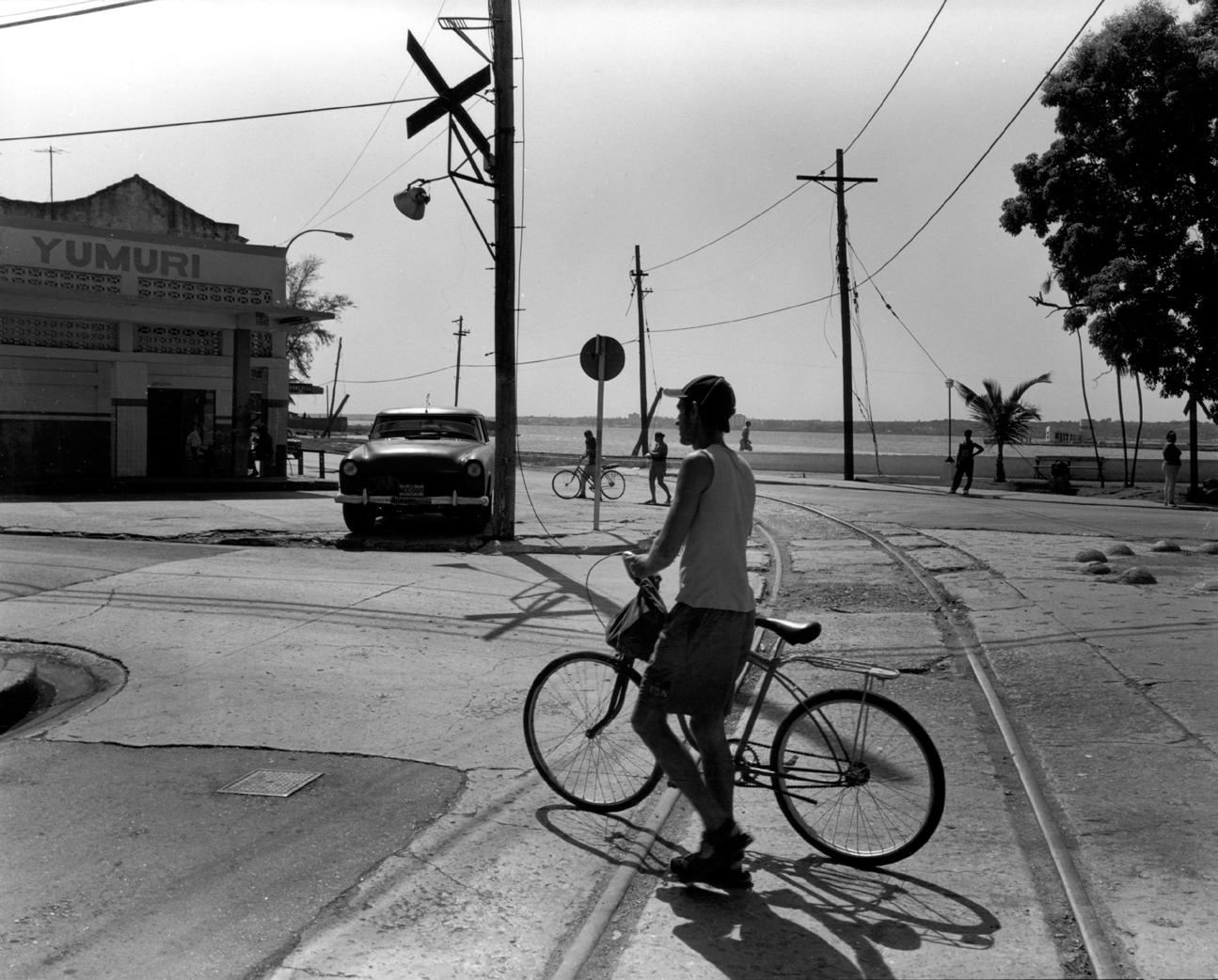

BRANDYWINE JOINS BLOOMBERG CONNECTS
Brandywine Museum of Art is delighted to announce that its joined 350 museums and cultural organizations around the world on Bloomberg Connects, a smartphone app that offers museum visitors unparalleled access to exhibitions and collections information before, during, or after their visit. Museums currently found on Bloomberg Connects include the Metropolitan Museum of Art, Guggenheim Museum, and the Phillips Collection. Brandywine’s guide features entries on favorite works from the collection as well as new exhibitions and acquisitions. The Bloomberg platform also includes accessibility features for visitors with low-to-no vision, such as alt-text, font size adjustment, and screen reader access.
To access Brandywine's digital guide, please visit the App Store or Google Play to download Bloomberg Connects to your smartphone today and start exploring the many cultural guides available at your fingertips.
Learn more at www.brandywine.org/guide
Bottom, left to right: Frank Stewart, Gorée Island Painter (or Slave Castle Back), 2006, chromogenic print, 35 x 42 ½ in. Guess Family Collection, Louisville, KY
Frank Stewart, Bicycle II, Cienfuegos, c. 2004–5 (printed 2022), gelatin silver print, 16 x 20 in. Collection of Sing Lathan and Bining Taylor
All photos © Frank Stewart
Top, left to right: Frank Stewart, Katrina: Hammond B-3, 9th Ward, New Orleans, 2007, inkjet print, 30 x 40 in. Collection of The Medium Group, LLC, courtesy of Larry Ossei-Mensah Frank Stewart, Stomping the Blues, 1997, gelatin silver print, 16 x 20 in. Collection of Rob Gibson, Savannah
9
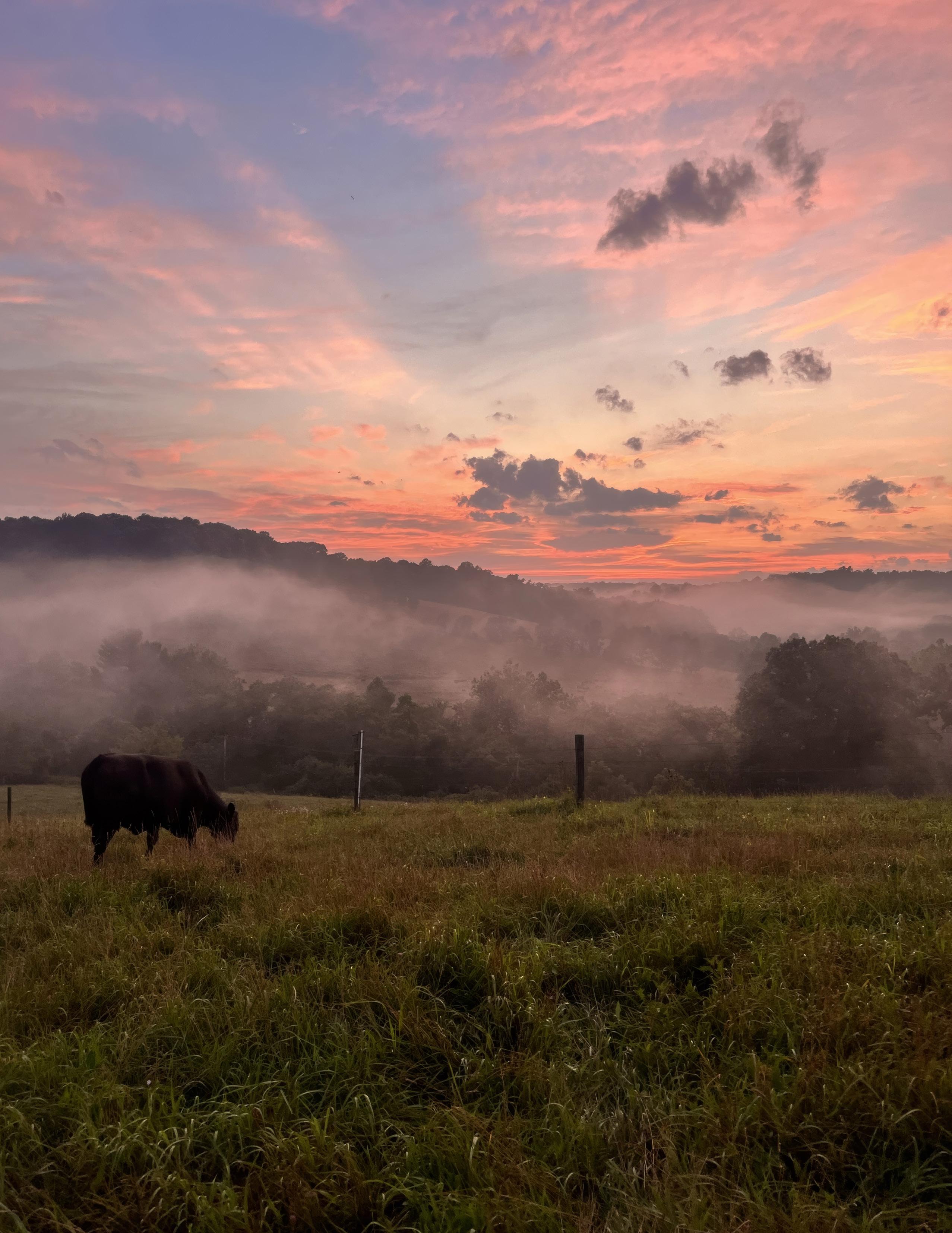
BEYOND CONSERVATION
A
Look at Landowner Stewardship

Conserving one’s land is only the first step in a lifelong relationship with landowner stewardship. Late last year, the Conservancy launched a new Landowner Stewardship Program to help its easement landowners with improving the overall ecosystem health of their properties on both a local and regional scale. In the following article, we spoke to several of our dedicated landowners to discuss the reasons why they decided to take extra steps to improve their property’s ecological value and the advice they have for other landowners getting involved in stewardship.
Reforesting with natives
When asked why they planted over 300 trees on their dairy farm in West Marlborough Township, the Bucklin
family emphatically responded, “It was a no-brainer once the project was explained. Anytime we can work with a local institution to plant trees on our properties, we jump at the opportunity. Reforesting portions of our properties, especially along streams, is a priority for our family.”
The Conservancy worked with the Keystone Ten Million Trees Partnership in obtaining the 335 trees planted on the Bucklin farm. The Bucklins were able to select species that were best suited for the planting location and conditions. Native species such as red maples, sycamores, eastern redbuds, and several others were chosen to infill open areas on their farm that are not being used for agricultural purposes.
Left: View from Buck Run Land and Cattle Co., a cattle operation run by Bill and Helen Elkins. Photo by Mike McGrath.
11
Above: View of Buck Run pictured along the Elkins Family property. Photo by Nate Hartley, American Forest Foundation.

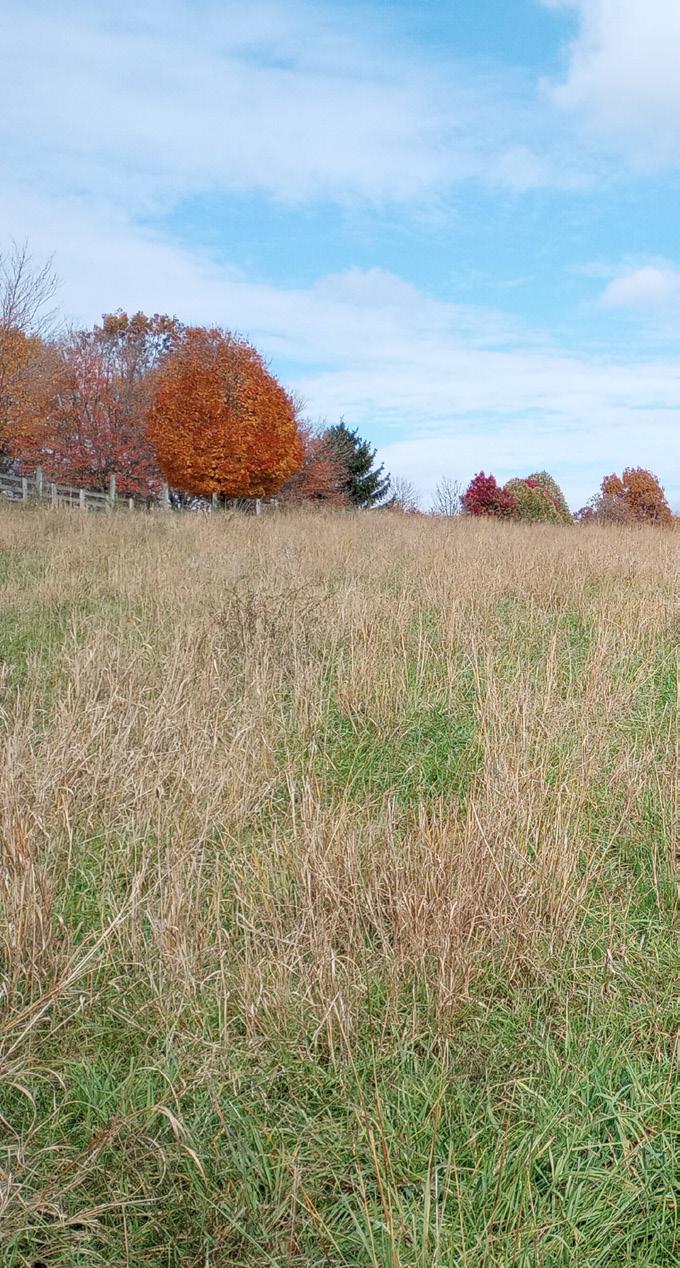
Native trees are not only beautiful to behold, but are best suited for our local conditions and provide immeasurable ecological benefits to the environment. “We chose from a fantastic list of native trees and picked the ones we felt would grow fast, look the best from the road and from on the farm, and also help create long-term habitats for birds and other creatures.”
The Bucklin family’s advice to potential landowners considering a similar project: “Plant as many native trees as possible on your properties. The short-term maintenance will be worth the long-term benefits for generations to come.”
Weeding out invasives
After moving into their home on Apple Grove Road in 2021, Jake and Becca Kaplan didn’t waste any time working to remove invasive plant species growing throughout their property. “Watching invasive species take hold and contribute to the imbalances of the ecosystem is like watching a family member succumb to illness,” said Jake.
The Kaplans started with targeted species such as bush honeysuckle, multiflora rose, tree-of-heaven, and Russian olive. As their efforts yielded space on the land, they began to plant native trees and shrubs to fill the void left behind as well as to stabilize and protect the small stream running through their property. The overreaching goal for Jake and Becca is to reinstate a healthy ecosystem of native species on their land that not only hosts a diverse range of plants and animals, but also sustains itself with minimal input.
Recognizing that this goal won’t be achieved overnight, their advice to others interested in improving the habitat on their land is, “Hurry up and get started!” Jake works towards their goals whenever he can, adding that 15 minutes here and there go a long way in addition to the many Sundays they devote to the cause.
Understanding that it can be intimidating to start a stewardship project on your land, Jake recommends starting with a smaller project that is easily managed to completion rather than tak-
ing on a larger project that may need to be repeated or redone several times to achieve the objective.
Implementing adaptive grazing
Bill and Helen Elkins have been longtime conservation leaders in their community since they became involved in the Brandywine’s unprecedented effort to preserve over 5,300 acres in Chester County in 1984, known as the King Ranch Project. These days, their cattle operation, Buck Run Land and Cattle Co., raises 100% grass-fed beef with a focus on the preservation of the farm’s natural resources.
The strategy for their farm is adaptive grazing, which avoids over-grazing by mimicking the pattern of a migrating herd. Utilizing portable shaders and solar-powered waterers, cattle are moved to different grazing spots using polywire, allowing the cows to access a different strip each day. The portable shaders keep the cattle away from the edges of woods and streams where they previously went
12

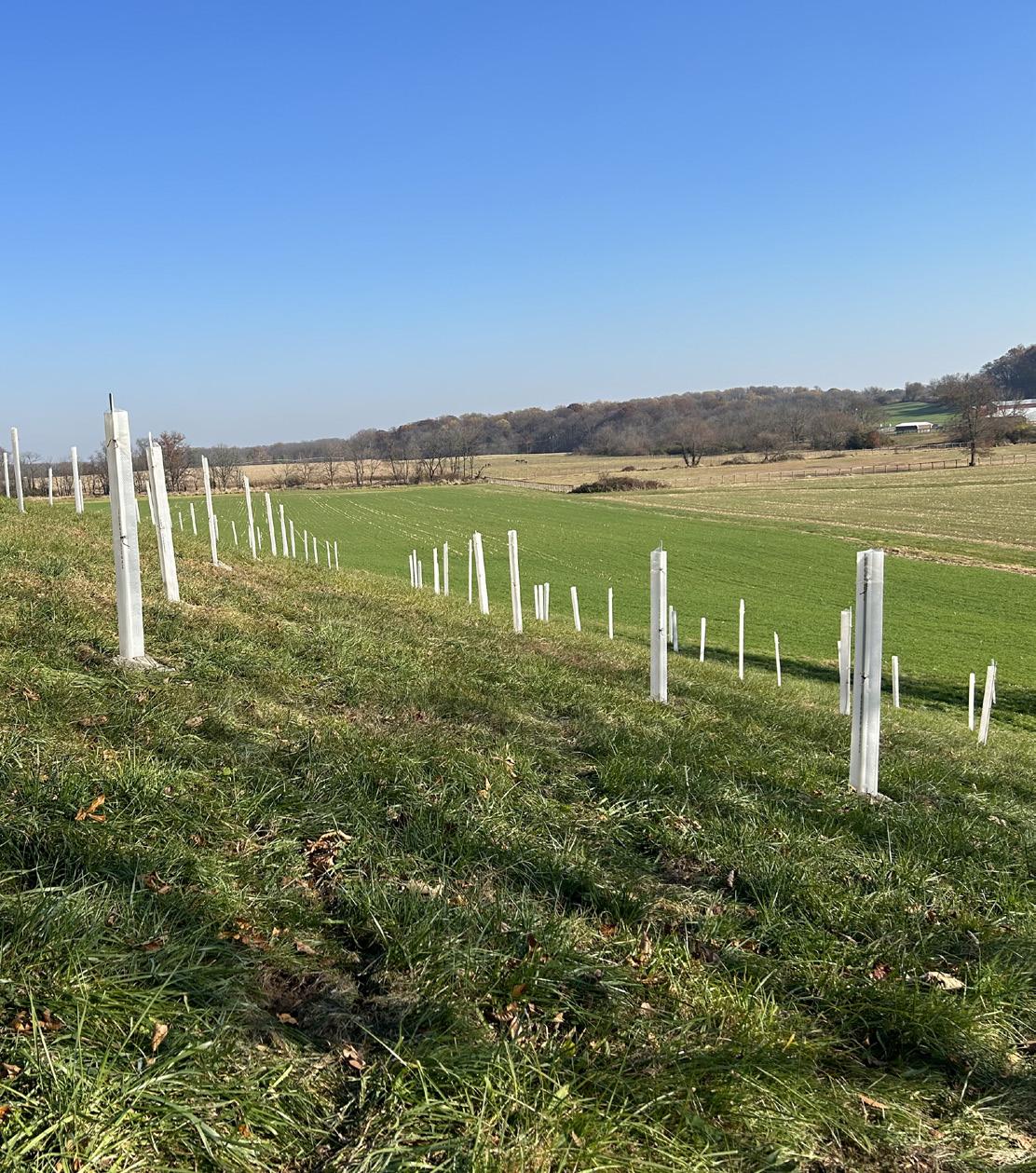
to cool off, protecting these sensitive resources. The cattle do not eat the grass all the way to the ground, helping minimize erosion and increase groundwater infiltration, and are in place long enough to mix the manure and urine into the soil without creating a problem with concentrated waste. In this way, the grazing animals improve soil health rather than damaging it. From Bill's perspective, adaptive grazing is a win-win. “Grazing cattle maintain the landscape, fertilize the soil, and produce healthy meat.”
Buck Run Land and Cattle Co.’s stewardship goes far beyond their farming practices. When the Conservancy put out a call for easement landowners to participate in the Family Forest Carbon Program (FFCP), Bill and Helen were among the first to respond. They enrolled in the program and in return received a detailed report of the condition of their woodlands, including the strengths and areas that could use improvement. In addition, they receive a payment each year that they can use for whatever they need to implement environmental improvements
on their property. This year, they utilized the money to help remove dead and dying ash trees across the farm. In the future, Helen hopes to use the funding to tackle the stewardship goals outlined in the FFCP’s report.
Land stewardship and you
Land stewardship can take on many forms, such as planting trees, implementing agricultural best management practices, or tackling invasive species, but they all have one goal in mind: to protect the land in perpetuity for the health of the overall ecosystem and for enjoyment by future generations to come. But you don’t need to be an easement owner, or even a landowner, to be a good steward of the land! Everyone can get involved in land stewardship, whether it’s through planting a native tree in your backyard, joining a local organization’s river clean up, or even just by picking up trash when you are out on a hike. n
Warm
A
Above, left to right: Jake and Becca Kaplan pictured with fruit trees they planted on their property.
Season Grass meadow, planted by the Elkins Family so that their cattle would have something to eat in the summer. The cattle love the switchgrass (Panicum virgatum), a native warmseason grass. Photo by Nate Hartley, American Forest Foundation.
13
recent tree planting on the Bucklin Family's property featuring saplings provided by the Keystone Ten Million Trees Partnership.

CELEBRATING THE LEGACY OF KUERNER FARM
In May of 1999, the Brandywine Conservancy & Museum of Art acquired the 33 acres in Chadds Ford known as the Kuerner Farm. At the time, George A. “Frolic” Weymouth, Chairman of Brandywine’s Board of Trustees, declared, “Thanks to the philanthropic spirit of Karl Kuerner Jr. and his family, this landmark of great historic and cultural significance will be preserved.” Over the years, Weymouth would often comment how it was one of the most generous acts of philanthropy he had ever witnessed. This spring marks the 25th anniversary of this key moment in Brandywine’s history.
Visitors to the Farm today go there seeking deeper understanding and connection with Andrew Wyeth, who created work on or about the Farm from the time he was a teenager. Brandywine Interpreters walk them through the property and point out the locations preserved as they were, where Wyeth made such paintings as Groundhog Day (1959) and Spring Fed (1967).
The history of the Kuerner family brings the property to life for many on Brandywine's tours. German-born Karl Kuerner Sr. served as a machine gunner in World War I but became a sheep herder after the war. In 1923, he left his homeland behind, bound for Philadelphia and a life away from his war-torn country. In 1925, Karl’s wife, Anna, and their young daughter, Louise, joined him in Philadelphia, and the following year the family moved to Chadds Ford. They rented the property, which was then known as Ring Farm, until they purchased it outright in 1940.
Three generations of Kuerners lived in the imposing three-story white farmhouse over the decades, raising cattle and crops. Andrew Wyeth developed a particularly close relationship with Karl Sr., which became even more important to him after the death of his own father, N.C. Wyeth, in 1945. He painted the German immigrant many times over his career, most notably in the stoic temperas Karl (1948) and Spring (1978). Kuerner Farm was like a second studio to Wyeth, who moved among the family members, observing them in their day-to-day chores, while painting.
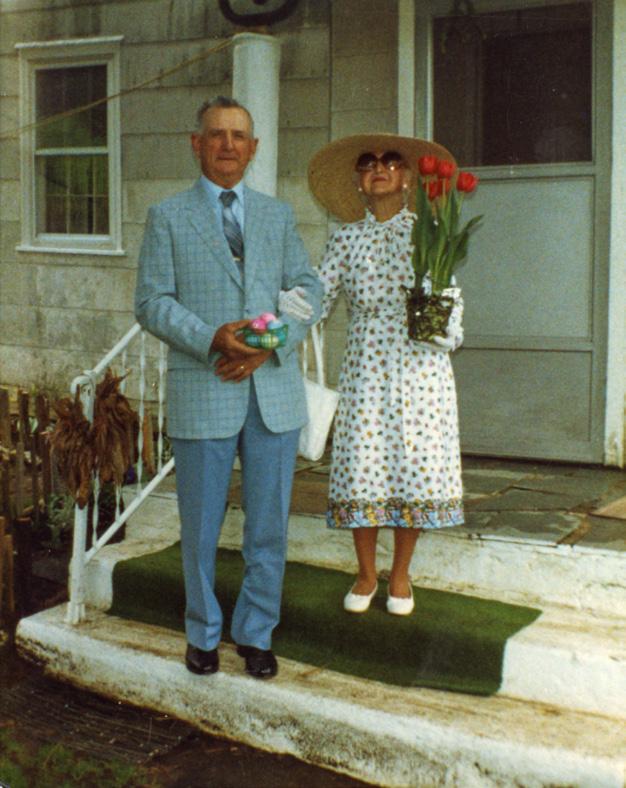 Page 14: Kuerner Farm photographed in 2023
Above:
Page 14: Kuerner Farm photographed in 2023
Above:
15
Karl Kuerner Jr. with his mother, Anna Kuerner, in the mid-1980s.
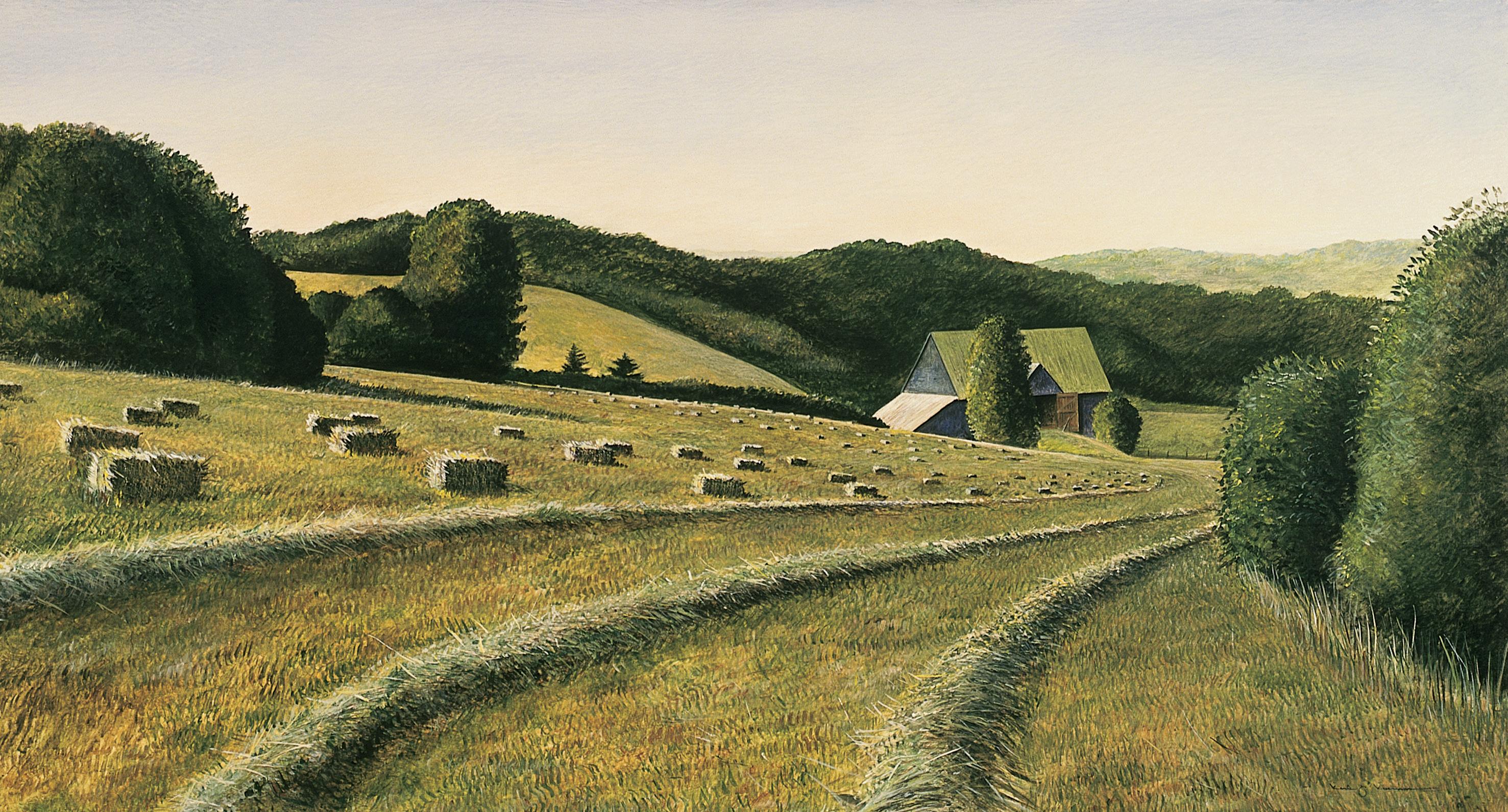
The preservation of Kuerner Farm includes care of the house, barn, and other outbuildings. Through Brandywine’s efforts, the Farm was added to the National Register of Historic Places. It was Karl Jr.’s hope that the Farm, which dates to the Revolutionary era, would be protected from development. Along with his son, Karl. J. Kuerner, he organized his siblings, purchased their shares of the Farm, and coordinated the donation to Brandywine, though he continued working the property until his death in 2018.
Karl J. Kuerner, the third generation to work and live on the land, grew up in an environment that stressed the work ethic of farmers and the appreciation of art because of the Kuerners’ relationship with the Wyeths. As a young artist, he received advice and critiques from both Carolyn Wyeth and Andrew Wyeth and went on to pursue a career as a painter. He is currently the focus of Brandywine’s exhibition Karl J. Kuerner: The Continuity of Creativity (on view through May 19), and he leads popular painting classes for the Museum on the grounds of the Kuerner Farm seasonally throughout the year.
"The Kuerner property holds a wonderful history and a bright future with many artistic discoveries still to be made," said Karl J. Kuerner. "The Farm witnessed so much over the course of its existence and continues to sustain those who see history and art as intertwined, much as the lives of the Kuerners and the Wyeths were intertwined on this land. It is a landmark for both land conservation and art. I know my father would be thrilled by how the Farm still thrives as a part of the Brandywine Museum of Art and what the future holds.” n
Tours of the Kuerner Farm are available this season on selected Fridays beginning in April. Continuing the Farm’s artistic legacy, artists are also invited to participate in plein air sessions the Brandywine hosts on the property each year.

16


Page 16, top to bottom
Karl J. Kuerner (b. 1957), First Cutting, 1992, acrylic on panel, 23 1/3 x 44 1/2 in. Collection of Dr. Raymond Puzio.
© Karl J. Kuerner
Karl Sr. and Karl Jr. standing at the entrance to the Kuerner Farm, ca. 1945. Photo courtesy of the Kuerner family.
Above, left to right
A plein air event held at Kuerner Farm.
Karl J. Kuerner continues to live and work on Kuerner Hill today—located adjacent from the Farm, across Ring Road— that has an amazing view of the Kuerner Farm and the valley below as a constant inspiration.

Karl J. Kuerner The Continuity of Creativity
On view through May 19, 2024
17
THINKING BIG PICTURE WITH MULTI-MUNICIPAL PLANNING
While land conservation has always been at the core of the Brandywine Conservancy’s mission, early on we also recognized the importance of complimentary approaches in protecting and conserving the land, water, natural, and cultural resources throughout the Brandywine-Christina watershed. One approach has been to offer municipal planning through the Conservancy’s Municipal Assistance Program.
Acknowledging that not every acre can be conserved, Brandywine’s municipal planning efforts offer services that provide long-term guidance and regulatory tools to ensure that development within a community is compatible with other land uses and occurs in a manner that is sensitive to our shared natural and cultural resources. Within Chester County, residents have been fortunate that the Chester County Planning Commission (CCPC) advocates for and supports wise planning, and through its Vision Partnership Program (VPP) provides cash grants to help municipalities to complete planning projects and achieve greater consistency with the County’s Comprehensive Plan, Landscapes3.
Providing the legislative framework that empowers municipalities to plan in our state, the Pennsylvania Municipalities Planning Code outlines the planning tools at our disposal and how they may be enacted. One such tool is the Comprehensive Plan, which examines all aspects of municipal management and administration, including land use, regulatory ordinances (that can be used to provide for the protection of natural and cultural resources), and the provision of community facilities, services, and infrastructure. Completed every 10 years, the Comprehensive Plan provides a blueprint for municipal policy regarding future land use and preservation.
While a municipality can choose to plan on its own, there are advantages to planning with its neighbors in a multi-municipal capacity. By planning cooperatively, municipalities can share the responsibility of providing for their fair share of development in areas that are best suited; consider preservation efforts at greater geographic scales; and provide for the efficient and cost-effec -
tive provision of facilities and services, including recreation and public safety.
Planning Together for Future Growth
For the Brandywine Conservancy, two key regional planning efforts are significant in that they not only provide tangible benefits to the municipalities involved, but they also serve as key areas for our mission-related work. They have also both benefited from funds awarded through the County’s VPP grant program.
In the headwaters of the Brandywine, with the assistance of our Municipal Assistance Program, the municipalities of Honey Brook Township and Honey Brook Borough have planned together for many years. This cooperative long-range planning effort provides synergy in ensuring that development occurs within the Borough, promoting its revitalization and ensuring its vitality for both Borough and Township residents. In turn, this permits the Township to focus its attention on protecting its agricultural heritage and active farmland, a much-cherished resource and crucial element of the local economy.
18
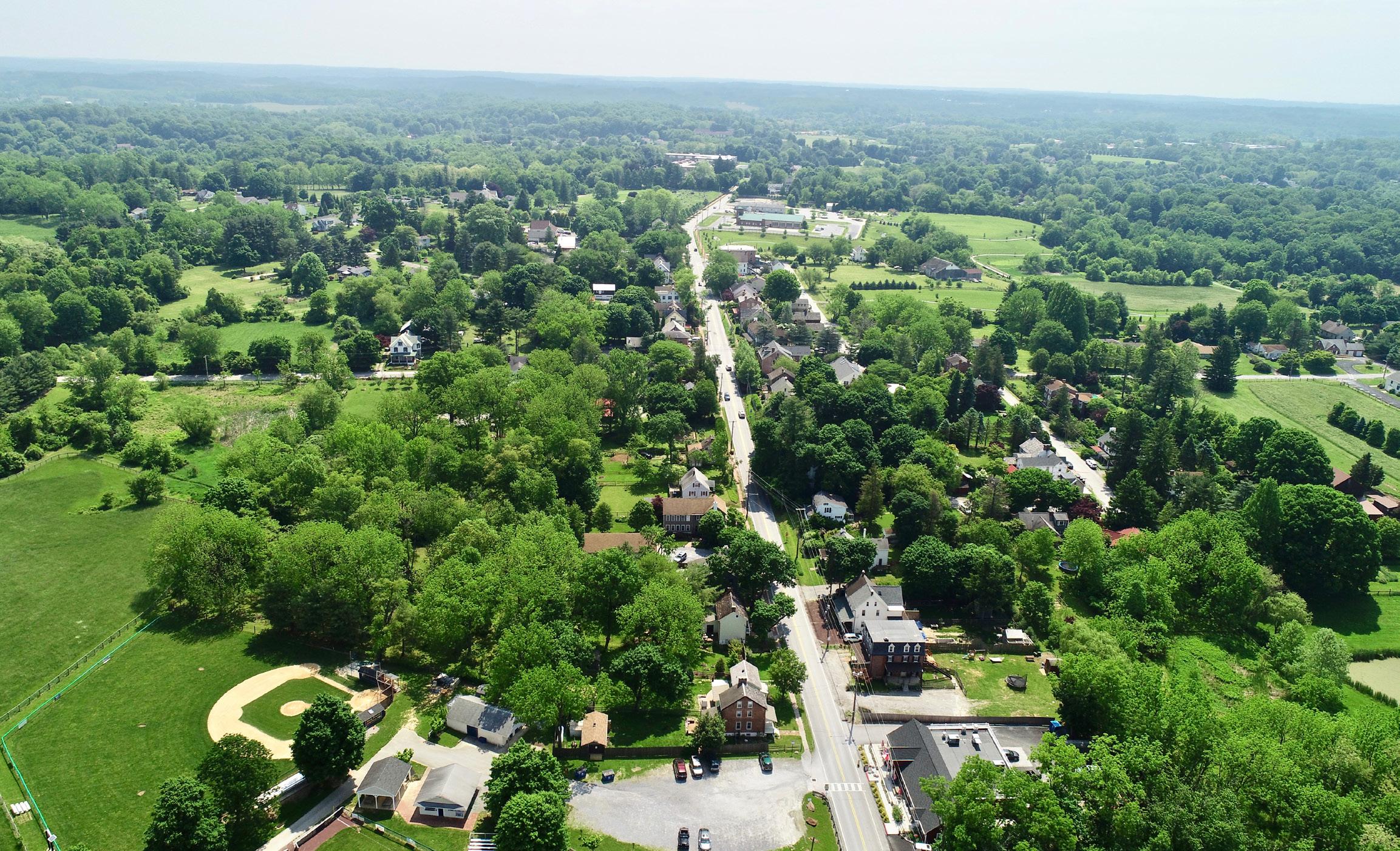
In the three municipalities that make up the Unionville Region, which represent a good portion of the conserved King Ranch lands, the Brandywine Conservancy is currently finalizing an update to their joint Comprehensive Plan that, like the example above, maintains a focus on allowing for development in areas best served by the transportation network, while protecting the rural lifestyle and landscapes of the greater King Ranch area. This cooperative effort enables the municipalities to work together to prioritize the protection of the area's important natural resources.
A Model for Success
The CCPC’s Community Planning Division has a long history of working with multi-municipal planning groups. From the Federation of Northern Chester County Communities (nine municipalities in the northern tier) and other multi-municipal groups throughout 1980–early 2000s, to more recent activity in the Phoenixville, Pottstown, and Oxford areas, regional planning has always been a high priority.
In 2007, the six communities that make up the Oxford Region, including Oxford Borough, East and West Nottingham, Upper and Lower Oxford, Elk, and East Nottingham Townships signed on to develop a Multi-municipal Plan. David Ross, a Supervisor in West Nottingham Township when the Plan development began, said “We were in the middle of revising our West Nottingham zoning ordinance to implement the goals of our own recently adopted Comprehensive Plan. In doing this, we realized that the effectiveness of the zoning districts we were contemplating depended critically on what was going on in the surrounding portions of the region. Having some sort of process for addressing pressures on the region as a whole is just common sense."
While working through the regional planning issues took additional time, it was worth the extra effort when in 2012 all six municipalities adopted the Plan and signed an Implementation Agreement to ensure that local planning would honor the adopted Multi-municipal Plan policies. As a result, the Oxford Region Planning Committee (ORPC) was established
and has been working together ever since, meeting monthly to discuss and address planning issues impacting the region. In January 2024, the ORPC began work on an update to their Plan and look forward to expanding the level of coordination and cooperation that began nearly two decades ago.
Municipal planning is just one of the Conservancy's many approaches to achieving our mission. Along with the work of our colleagues in Land Conservation, Land Stewardship, Community Services, and Environmental Education, the Municipal Assistance Program plays a key role in ensuring a healthy environment and vibrant communities for future generations. n
Above: Aerial view of Unionville, PA. Photo by Above Ground Level Droneworks
19
Brandywine Conservancy would like to thank Mark Gallant, Senior Community Planner at the Chester County Planning Commission, for his contributions toward this article.
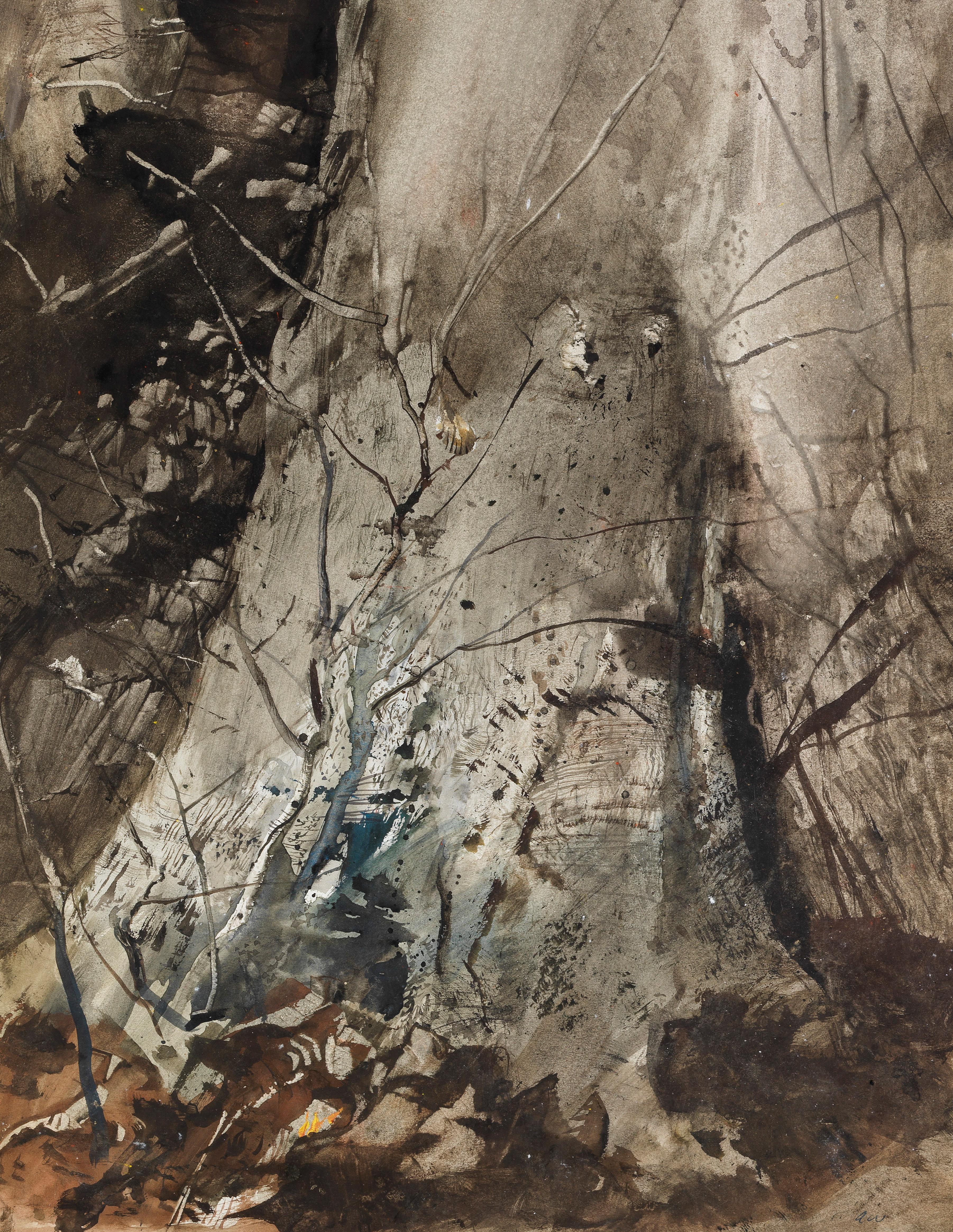
INSIDE EVERY LEAF & TWIG: ANDREW WYETH’S BOTANICAL IMAGINATION
Now through September 15, 2024
Now on view, Every Leaf & Twig: Andrew Wyeth’s Botanical Imagination features 39 watercolors and drawings, many of which have never been exhibited before, exploring the artist’s focus on the fragile rhythms and intimate dramas of plant life. This exhibition—the latest to result from the Brandywine’s unique partnership with the Wyeth Foundation for American Art— reveals an insufficiently understood and especially timely aspect of Wyeth’s work, as the very web of botanical relationships that inspired the artist is impacted by rapid changes in the ecosystem.
To use a distinctly appropriate metaphor, the seed of this exhibition was planted by Amy Morey, one of the three expert and experienced former staff of the Wyeth family who became valued Brandywine employees in 2022. Amy now serves as Associate Collection Manager for the Andrew & Betsy Wyeth Study Center, overseeing our Maine office on the campus of the Farnsworth Art Museum. Amy recognized that there is something highly unusual and original in Andrew Wyeth’s approach to inanimate nature. With Amy as lead curator for the project and one of the essayists for
the accompanying catalogue, the Wyeth Study Center’s collaborative team of four set about selecting suitable works for a focus on the ways botany was useful to Wyeth amid the 7,000 artworks included in the Wyeth Foundation's Andrew & Betsy Wyeth Collection, now managed by the Brandywine.
The artworks that came to light are truly revelatory, pointing to an aspect of Wyeth’s practice that has been inadequately understood. In his response to individual specimens of plant life, we see a meditative method grounded in time spent alone
walking the fields of mid-coast Maine and Chadds Ford. This discipline called to mind the work of the nature writer Henry David Thoreau, famous for his solitary idyll at Walden Pond, where he reflected on the rhythms and beauties of “every leaf and twig,” giving us our title. We know Thoreau was an important reference for Wyeth—the artist was born 100 years to the day after the writer, giving rise to the mythology that there was a cosmic connection between the two men—and the exhibition includes a well-thumbed family copy of the book Walden, or Life in the Woods.

Page 20:
Andrew
All works © 2024 Wyeth Foundation for American Art / Artists Rights Society (ARS), New York
Wyeth (1917-2009), Corner Of The Woods Study (detail), 1954, watercolor on paper, 21 ¾ x 14 in. Collection of the Wyeth Foundation for American Art, B0317
Left:
Andrew Wyeth (1917-2009), Buttonwood, Study for The Hunter, 1943, drybrush on paper, 19 ½ x 29 ½ in. Collection of the Wyeth Foundation for American Art, B0575r
21

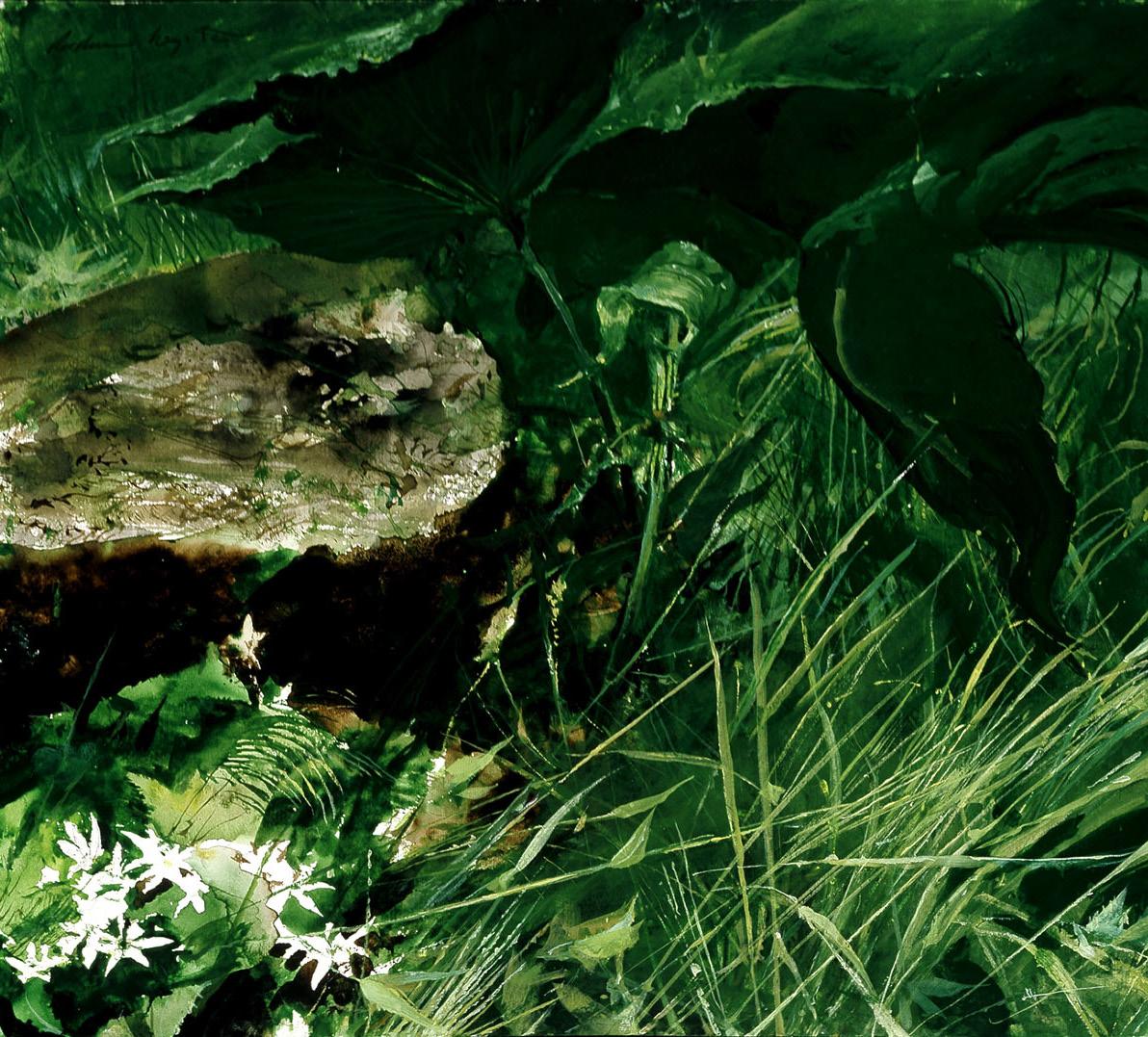
Wyeth’s plant portraits, as we might think of them, cannot be confused with works of botanical illustration. On the contrary, these humble subjects reveal a constant of Wyeth’s methods: that his visionary practice made free use of observed or wholly imagined subject matter as his purposes required, remaking so simple a subject as a dry corn stalk in November, for example, as a vision of knights on horseback with banners fluttering in the wind. While the illustrated letter that gives us this extreme example is especially revealing, this free imagination is evident throughout the show. He revels in the colors, textures, and patterns of plant life, zooming in rather than zooming out, and showing his connections to one of his artistic heroes in
the process: Albrecht Dürer (1471-1528), whose work The Large Piece of Turf Wyeth cited as a particular inspiration.
Consultation with experts in the ecosystems Wyeth painted was central to this project, as extreme weather and warming temperatures impact both poles of Wyeth world. Colleagues from across the Brandywine Conservancy consulted on the Pennsylvania works being exhibited, sharing comments for our wall labels on the specific species Wyeth depicted, their cycles of life, and why they might have spoken to the artist, and how they are being impacted since his lifetime. Through this partnership across our unique organization, we gain a new insight into an artist who was uncommonly attuned to the cycles of the natural world. n

Now available for purchase in the Museum Shop, this full-color, lavishly illustrated 136-page catalogue includes reproductions of the full Maine and Pennsylvania versions of this exhibition, and essays from the Wyeth Study Center’s Amy Morey and William L. Coleman, as well as coastal botanist Lauren Stockwell. This catalogue and the exhibition were made possible through the generous support of the Wyeth Foundation for American Art.
Purchase a copy at www.BrandywineMuseumShop.org.

Andrew Wyeth (1917-2009), Secret, 2008, watercolor on paper, 16 7/8 x 19 in. Collection of the Wyeth Foundation for American Art. © 2024 Wyeth Foundation for American Art / Artists Rights Society (ARS), New York
Letter to Merle and Elizabeth James, 1954, ink and watercolor on paper. Wyeth Foundation for American Art
Exhibition Catalogue for Every Leaf & Twig
Clockwise from top left: Albrecht Dürer (1471-1528), The Large Piece of Turf, 1503, watercolor on paper, 15 7/8 x 12 1/4 in. Albertina, Vienna, Austria
22
Announcing the new Andrew & Betsy Wyeth Study Center
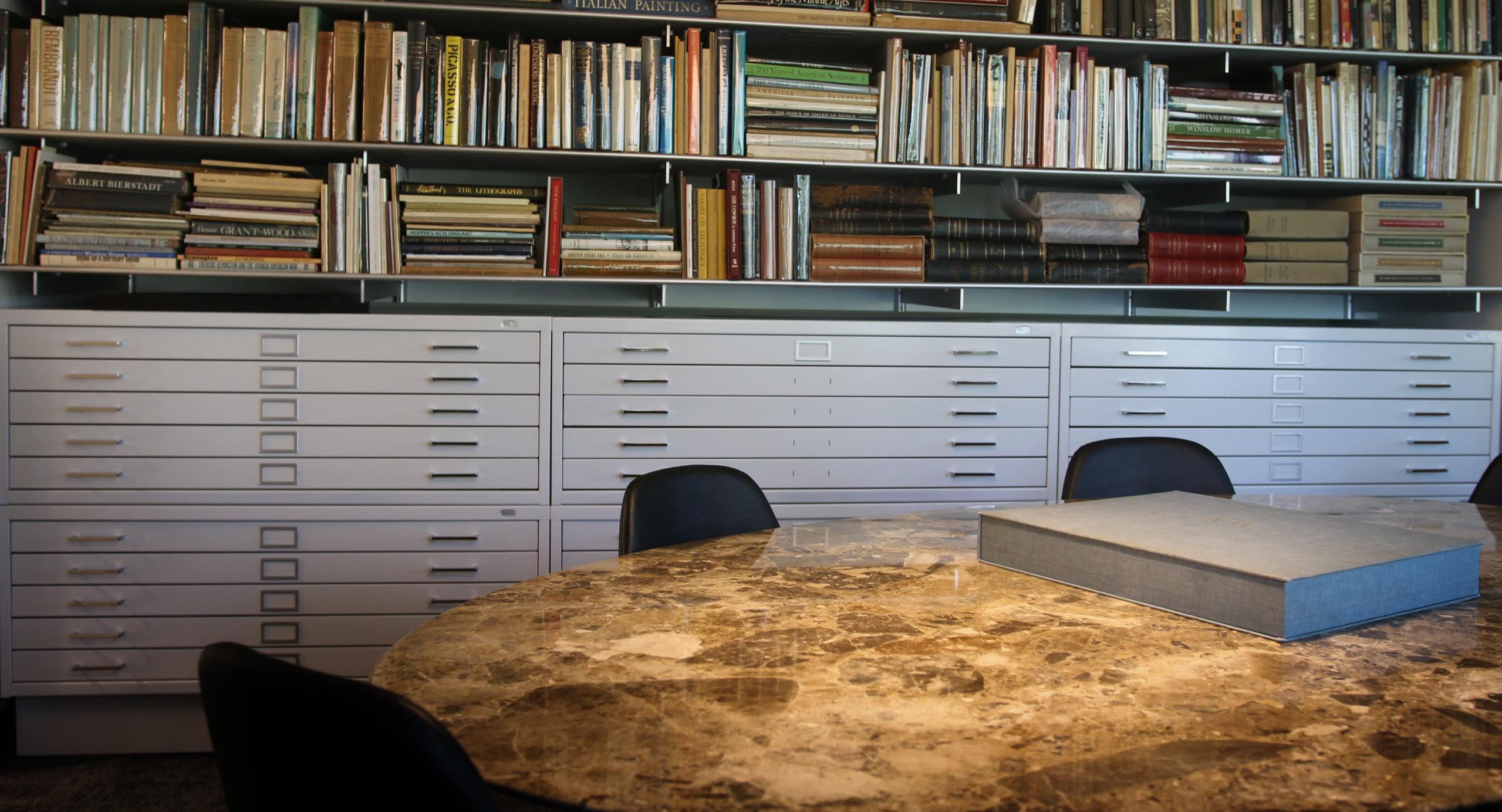
After more than a year of hard work, the Brandywine is excited to share the completion of the Andrew & Betsy Wyeth Study Center. In the following article, William L. Coleman, Ph.D., the Museum’s inaugural Wyeth Foundation Curator and Director of the Andrew & Betsy Wyeth Study Center, shares more about this exciting space and how it will be a key tool in our continued work to share new insights into the life and work of Andrew Wyeth.
This state-of-the-art collections care, research, and teaching facility on the second floor of the Museum building provides ideal storage for some 3,500 works of art by Andrew Wyeth, archival materials, and a substantial library for Wyeth studies, including the Wyeths’ personal library from their primary Chadds Ford home.
Made possible through the generous support of the Wyeth Foundation for American Art, the Study Center includes an intimate seminar space for course meetings, a main workroom that was laid out around a central table that was designed by Betsy James Wyeth herself, two dedicated vaults for easel paintings and works on paper, and generous workspaces for the Wyeth Study Center’s two Chadds Ford-based staff. (Two additional Brandywine employees work at our other pre-existing Wyeth Study Center
on the campus of the Farnsworth Art Museum in Maine.)
Currently this exciting space is open by appointment only to scholars, writers, artists, and students in higher education working on projects related to the unique creative partnership of Andrew & Betsy Wyeth. There is also a hope of offering small group visits for Brandywine supporters as space permits in the coming months, but we ask for your patience and understanding due to the fragility of the collections found throughout these secure spaces.
I’m pleased to report that as we begin to host our first study visits—from students in the elite Winterthur Program in American Material Culture and writers working on Wyeth books—that the Study Center is already becoming a key tool in our efforts to invite new voices
and perspectives into the Wyeth legacy and to make it ever easier to engage with Andrew Wyeth’s work in scholarly and creative projects.
On a personal level, I can’t tell you how thrilling it has been to have all this incredible artwork here on our campus now that the construction of this space is complete. There is no substitute for pulling out a sliding rack and seeing a masterpiece like the monumental watercolor Wolf Moon (1975) right in front of you instead of as a digital image on a screen. Having the art right at our fingertips will help us to continue to share exciting new insights into this body of work in the Andrew Wyeth Gallery, and with partner institutions nationally and internationally, for many years to come.
— William L. Coleman, Ph.D.
23
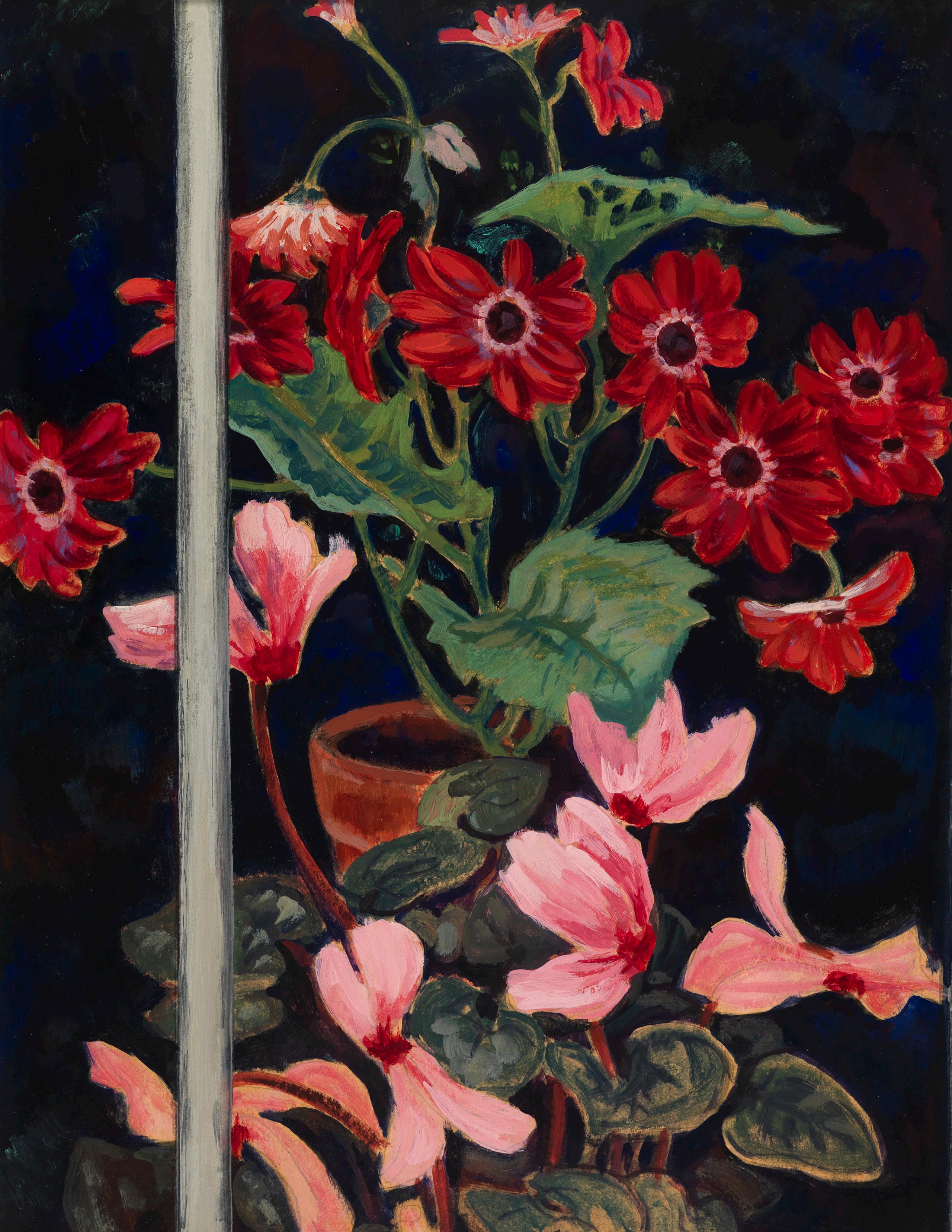
RECENT ACQUISITIONS AT THE BRANDYWINE

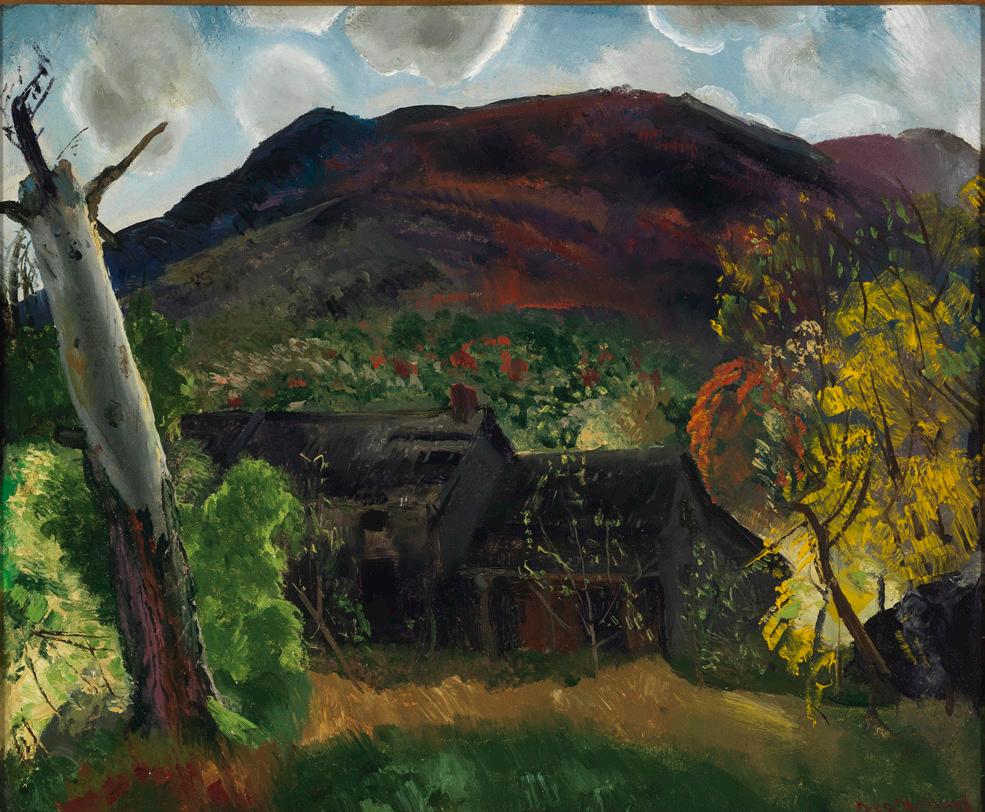
The Museum was thrilled to recently add three new acquisitions to its permanent collection, increasing our holdings of both modern and contemporary art. Below, learn more about each work, how they fit into Brandywine’s holdings, and when you can expect to see them on display.
Lancaster County native Charles Demuth’s (1883-1935) still life painting Red Cineraria and Cyclamen (ca. 1916-17) dates from an experimental period when the artist worked briefly in the medium of tempera. Demuth is a luminary among the American Modernists—a close friend of such major figures as Alfred Stieglitz, Georgia O’Keeffe, and Marsden Hartley, whose floral still life Petunia’s from Lachaise’s Garden was acquired by the Museum in 2022. The two paintings will be installed next to each other in the near future.
George Wesley Bellows's (1882-1925) landscape Blasted Tree and Deserted House (1920) creates a new interpretation of a classic Catskill Mountain scene with bold brushwork and color palette to match. This work is a perfect complement to Brandywine’s holdings of Hudson River School-related paintings. A member of the American modernist group known as “The Eight” and
The Ashcan School, Bellows was one of many artists who began his career in illustration before turning to the broader arena of easel painting and examining the modern city with a realist eye. He was equally well known for his visceral depictions of boxing matches as for his bucolic landscapes.
Jerrell Gibbs (b. 1988) is a Baltimore-based emerging artist who created the monumentally scaled Nous visited the Seine, but did not swim. One of several works he completed while living in Paris in 2022, it is part of a recent body of work that explores swimming and diving subjects as a metaphor for being transported to a different realm. Many of his works depict figures which he surrounds with beauty in order to thwart negative stereotypes of Black masculinity. This major painting will be included in a mid-career survey of Gibbs's work—his first one-person museum exhibition—organized by the Brandywine in fall 2025. n
Left: Charles Demuth (1883-1935), Red Cineraria and Cyclamen (detail), ca. 1916-17, tempera on board, 19 1/2 by 15 in. Purchased with Museum funds, 2023
Above, left: Jerrell Gibbs (b.1988), Nous visited the Seine, but did not swim, 2022, oil on canvas, 72 1/2 x 77 1/2 in. Purchased with funds provided by Mr. and Mrs. Rodman Moorhead, 2023. © Jerrell Gibbs
25
Above, right: George Wesley Bellows (1882-1925), Blasted Tree and Deserted House, 1920, oil on panel, 18 x 22 in. Purchased with Museum funds, 2023
EVENTS CALENDAR
Spring–Summer 2024
May 2024
1
ARTZ-Connect at Brandywine
11 a.m.–12 p.m.+
A welcoming virtual program for visitors with dementia and their caregivers.
5
Free First Sunday at Brandywine
9:30 a.m.–4:30 p.m.+
Enjoy free all-day admission to the Museum and join creative art activities for all ages.
10
Stroller Tour
10:30 a.m.^
A guided gallery tour designed especially for adults accompanied by babies.
11
Yoga on the Brandywine
10–11 a.m.
An inclusive and beginner-friendly yoga class designed for practitioners of all levels.
17 & 19
Plein Air Day at Kuerner Farm 9:30 a.m.–2:30 p.m.
Artists working in all media are invited to sketch or paint this National Historic Landmark.
22
Jamie Wyeth: A Virtual Conversation with the Artist
7 p.m.
Discover the sources of Jamie Wyeth’s creative inspiration in an online conversation between the artist and Brandywine Museum of Art Senior Curator Amanda C. Burdan, Ph.D.
June 2024
2
Free First Sunday at Brandywine
9:30 a.m.–4:30 p.m.+
Enjoy free all-day admission to the Museum and join creative art activities for all ages.
5
ARTZ-Connect at Brandywine
11 a.m.–12 p.m.+
A welcoming virtual program for visitors with dementia and their caregivers.
6
Chef’s Table Dinner
6–9 p.m.
8
Yoga on the Brandywine
10–11 a.m.
An inclusive and beginner-friendly yoga class designed for practitioners of all levels.
15
Plein Air Workshop with Randall
Graham at Andrew Wyeth Studio
9:30 a.m.–4:00 p.m.
18
Kuerner Farm Plein Air Evening 4–8 p.m.
Artists working in all media are invited to sketch or paint this National Historic Landmark.
22
Nature Sketch & Stroll
9:30 a.m.–12 p.m.
An art and nature-themed walk and sketch program for all abilities.
23
Stewardship Walk at the Laurels Preserve
9–11 a.m.+
Event Information
Children & Family
Virtual Event
Tours & Talks
Workshops & Classes
Members Only
Special Events
Unless otherwise noted, all programs and events are ticketed and/or require advance registration.
For more information, program descriptions or to register, please visit brandywine.org/events
† Registration required, but free admission
* Free; no registration required
^ Free with Museum admission; no registration required
26
July 2024
17
Kuerner Farm Plein Air Evening
4–8 p.m.
Artists working in all media are invited to sketch or paint this National Historic Landmark.
19
Concerts in the Courtyard
6 p.m.
Enjoy a concert under the stars in the Museum’s outdoor courtyard.
20
Sensory-Friendly Saturday
9–10:30 a.m.+
Individuals on the autism spectrum and their families are invited to join us for early access to the Museum and creative and accessible activities.
21
Stewardship Walk at the Laurels Preserve
9–11 a.m.+
Enjoy a leisurely hike around the Laurels Preserve, guided by our Preserve Stewards, to discuss recent stewardship work on the property and the reasons behind the activities.
22 & 23
Virtual Talk with Victoria Wyeth
7 p.m.
Join Victoria Wyeth as she shares her uniquely personal perspectives on the art of her grandfather, artist Andrew Wyeth (1917-2009).
Museum Explorers Family Workshops
July 11, 18, 25 and August 1 10:00 a.m. & 11:00 a.m.
Creative workshops for children ages 3 to 10 accompanied by their grownups.
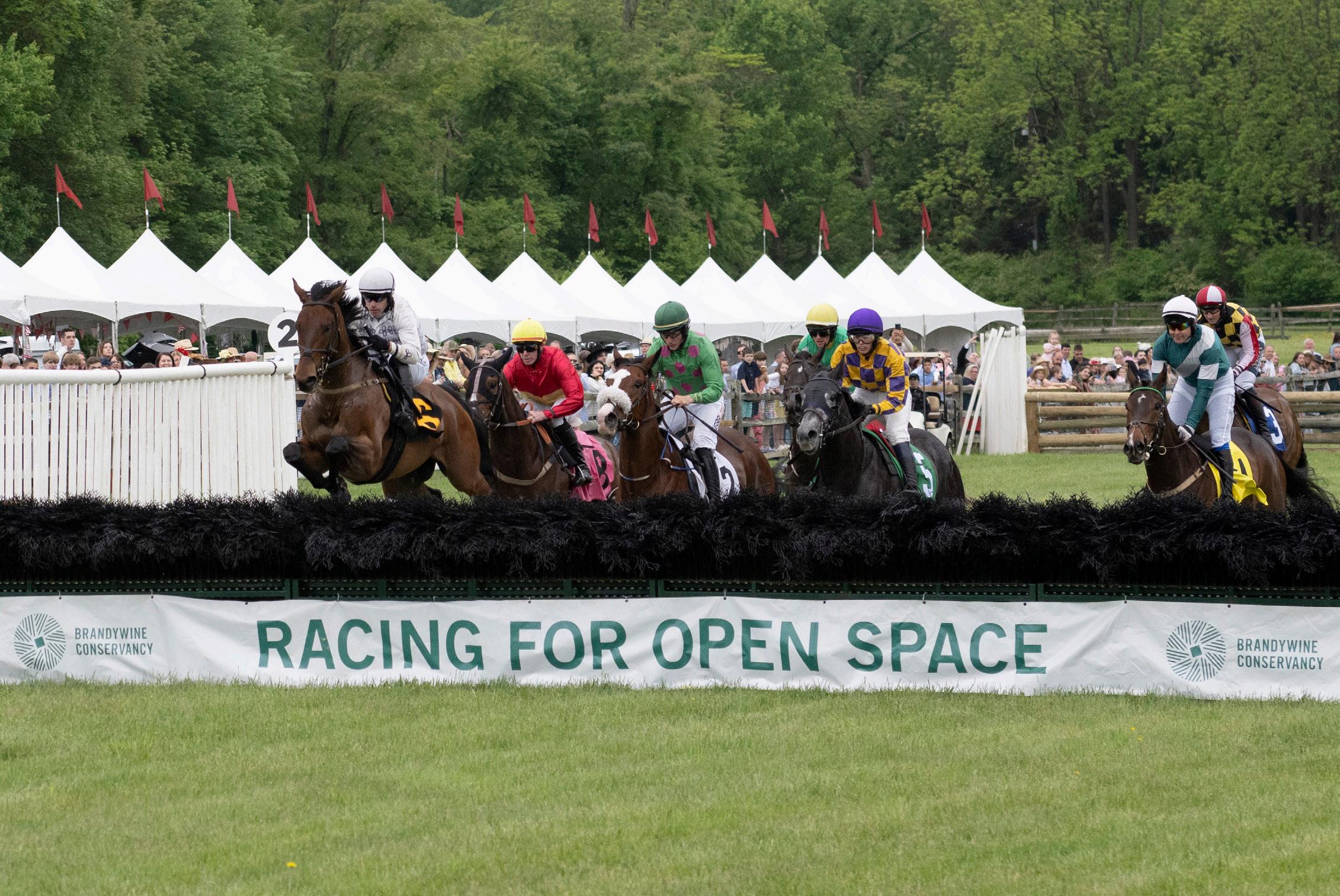
Radnor Hunt Races May 18, 2024
Celebrate 93 years of horseracing on the Main Line. With everything from amazing tailgates and fancy hats, to the parade of antique carriages and thoroughbreds racing for the finish, Radnor Hunt Races is a day filled with excitement and fun. It’s also about Racing for Open Space as all proceeds benefit the clean water and open space programs of the Brandywine Conservancy. Purchases your tickets by May 8!
27
Photo by Bob Plant
August 2024
4
Free First Sunday at Brandywine
9:30 a.m.–4:30 p.m.+
Enjoy free all-day admission to the Museum and join creative art activities for all ages.
9
Stroller Tour
10:30 a.m.^
A guided gallery tour designed especially for adults accompanied by babies.
10
Yoga on the Brandywine
10–11 a.m.
An inclusive and beginner-friendly yoga class designed for practitioners of all levels.
14
Meadow Walk
10–11 a.m.
A walking tour and up-close look at some of the late summer blooming plants that thrive in one of our meadows.
September 2024
14
Yoga on the Brandywine
10–11 a.m.
An inclusive and beginner-friendly yoga class designed for practitioners of all levels.
21
Bike the Brandywine Register to ride at BikeTheBrandywine.org
15
Kuerner Farm Plein Air Evening
4–8 p.m.
Artists working in all media are invited to sketch or paint this National Historic Landmark.
23
Concerts in the Courtyard
6 p.m.
Enjoy a concert under the stars in the Museum’s outdoor courtyard.
25
Stewardship Walk at the Laurels Preserve
9–11 a.m.+
Enjoy a leisurely hike around the Laurels Preserve, guided by our Preserve Stewards, to discuss recent stewardship work on the property and the reasons behind the activities.
29
Stewardship Walk at the Laurels Preserve
9–11 a.m.+
Enjoy a leisurely hike around the Laurels Preserve, guided by our Preserve Stewards, to discuss recent stewardship work on the property and the reasons behind the activities.
October 2024
2
ARTZ-Connect at Brandywine
11 a.m.–12 p.m.+
A welcoming virtual program for visitors with dementia and their caregivers.
6
Free First Sunday at Brandywine
9:30 a.m.–4:30 p.m.+
Enjoy free all-day admission to the Museum and join creative art activities for all ages.
12
Yoga on the Brandywine
10–11 a.m.
19
Barks & Brew
12–4 p.m.
An Oktoberfest celebration in the courtyard—canine friends welcome!

20
Stewardship Walk at the Laurels Preserve
9–11 a.m.+
24
Chef's Table Dinner
6–9 p.m.
28

SATURDAY, SEPTEMBER 21, 2024
RIDE a loop of 25, 45 or 62 miles in scenic Chester County
EXPLORE the scenery and history of the Brandywine Creek Greenway
SUPPORT clean drinking water
BIKETHEBRANDYWINE.ORG
20 24
IN MEMORIAM

Linda L. Bean (April 28, 1941 – March 23, 2024) was an entrepreneur, philanthropist, and devoted Maine resident who passionately served as a Brandywine Conservancy & Museum of Art trustee for nine years. Granddaughter of Leon Leonwood (“L.L.”) Bean, her deep interest in the Wyeth family of artists—N.C., especially—drew her to the Museum a decade ago. She gave generously in support of Brandywine’s general operations and exhibitions and furthered scholarship both here and through the N.C. Wyeth Research Foundation and Reading Libraries, Inc.—a non-profit she founded in Needham, Massachusetts to promote the study of the Wyeth family. A naming gift for the Linda L. Bean Gallery, where both N.C. and Jamie Wyeth's work is enjoyed, was given as part of our 50th Anniversary Campaign.
Bean cared deeply about her native state and devoted herself to conserving its land, shoring up its communities, promoting tourism, and supporting LifeFlight of Maine to ensure that its rural and offshore residents would have timely access to emergency services and hospitals. She also shared her business acumen to assist Brandywine's development of the Millstone Café, offering the guidance and coaching of her restaurant experts as we developed our own in-house Café staff. At Brandywine, we will always remember Bean for her friendship and for her generosity, which allowed us to develop and host many special exhibitions and to protect the landscape that was such an inspiration to N.C. Wyeth and his family of artists.
 Photo by Marien Parsons
Photo by Marien Parsons
MEMORIALS & TRIBUTES
The Brandywine Conservancy & Museum of Art gratefully accepts and acknowledges gifts in honor or in memory of family and special friends, and in appreciation of our staff and volunteers. Recent gifts include:
IN HONOR OF JOSEPH & ANN ARMSTRONG
Mr. & Mrs. Henry P. Howell
IN MEMORY OF BARBARA OAKES BARBER
Jonathan T. Barber
IN HONOR OF DR. PATRICIA BLAKESLEE
Mrs. Courtney NathanMaterdomini
Mr. Robert Materdomini
IN MEMORY OF DIANE LOUISE BRICKER
Ms. Belinda Izzi Collins
IN HONOR OF AMANDA BURDAN
Mr. & Mrs. David Freilich
Dr. Margaret Mukherjee
IN MEMORY OF JOHN R. COLEMAN
Mr. Carl Tannenbaum
Mr. Stephen Ulan
IN HONOR OF DR. WILLIAM L. COLEMAN
Mr. Peter Goldberger
Mr. & Mrs. Marc Inver
IN HONOR OF MARSHA COPE
Ms. Lynne Cullinane
IN HONOR OF DIANA MILLER CUTLER
Ms. Charlotte S. Roede
IN MEMORY OF MATTHEW JAMES DAVIS
Mr. & Mrs. James Davis
IN HONOR OF MRS. MARTHA FREIBOTT
Mrs. Linda Handling
IN HONOR OF KIM GORDON
Mr. & Mrs. Charles Fleischmann V
IN MEMORY OF MS. JOANNE GORMEL (in addition to previous gifts)
Ms. Deborah Buhrman
Dr. John Newton
IN MEMORY OF DOTTIE HUFF (in addition to previous gifts)
Ms. Patricia Bradt
IN HONOR OF CATHY & JOE HUSTON
Mr. & Mrs. Mark S. Finkelstein
IN MEMORY OF KAREN D. JANNEY
Ms. Cindie Blackmer
Ms. Kathleen Herrington
Mr. & Mrs. Arthur Hochner
Ms. Kristen Parris
Ms. Sharon McCarthy
Mr. James Ware
Mr. James Wood
IN MEMORY OF GEORGE-ANNE KELLY
Dr. Päivi Huhtela
IN HONOR OF LOIS LYNCH
Ms. Patricia Kosinski
IN HONOR OF MARK & JESSICA MICHELL
Ms. Margaret Michell
IN MEMORY OF JOHN DAY & NANCY MOHR (in addition to previous gifts)
Mr. & Mrs. Philip D. Lee Jr.
IN MEMORY OF LINDA K. PRICKETT
Mrs. Ginny Cole
Ms. Allaire Hummel
Mrs. Paula Mutzel
Mrs. Caroline duPont Prickett
IN HONOR OF SUZANNE M. REGNIER
Abby Van Pelt & Jeff Silverman
Bill & Kay Iredale
IN MEMORY OF MICHAEL J. ROTKO
Mrs. Pamela K. Brumfield
Mr. Mark Coblitz
Mr. & Mrs. Antelo Devereux Jr.
Carol & Harry Heller
Mrs. Richard I.G. Jones
Mr. Steven Klemenz
Mr. & Mrs. John Manning
Ms. Heidi Militana
Ms. Karen Rabb
Justin Stralka & Coleen Kinsella
Cuyler H. Walker
Ms. Margaret T. Walters
IN HONOR OF ALEXANDER SCOTT & LEATRICE ELLIMAN
(in addition to previous gifts)
Ms. Angela M. Benjamin
Mr. John Hodges
Mr. & Mrs. Ed Cuervo
Mr. Cortright Devereux
Ms. Margaret Devereux
Ms. Nicolette Graham
Ms. Maisy Grassie
Mr. & Mrs. Peter B. Jonas
Dr. Delaney Osborn
Drs. Christopher & Carina Petersen
Mrs. Meredith Rotko
Mr. John Schoonover
Ms. Stephanie Sinson
IN MEMORY OF BILL SELLERS
(in addition to previous gifts)
Mrs. Deborah Sellers
IN MEMORY OF DANIEL J. SNYDER III
Mr. Robert B. Snyder
IN MEMORY OF EDWARD
ALLEN SPANG
Dr. Deborah Acorn
Dan M. Burgess
Ms. Diane Cannon
Katie & Greg Gallagher
Stephen & Mary Ann Gring
Mr. & Mrs. William W. Goudie
Dr. Brett Goudie
Ms. Twonette S. Hawkins
Kelly’s Sports
Mrs. Mary F. Patrick
Ms. Penny Radach
Miss Erinn Rigney
Shannon & Tim Schloneger
Mrs. Gertrude G. Steel
Ms. Paula Wagner
The Honorable Jessica Wiley
IN MEMORY OF EDWARD TRAHAN
Ms. Susan B. Trahan
IN MEMORY OF LOUIS C. AND BARBARA R. WASHBURN
Ms. Elizabeth W. Pesce
Washburn Family Foundation
IN HONOR OF FRANCIE & MAC WEYMOUTH
(in addition to previous gifts)
Archbold Hufty Leidy Foundation
Ms. Lydia Bartholomew
Donna & Michael Dolan
IN MEMORY OF GEORGE A. “FROLIC”
WEYMOUTH
(in addition to previous gifts)
Ms. Evelyn M. Carlson
Meemie Sullivan
IN MEMORY OF ROBERT WOODWARD
Janet Izzo
IN MEMORY OF CAROLINE PYLE
WYETH
(in addition to previous gifts)
N. Convers Wyeth & Edi Wyeth
31

P.O. Box 141, Route 1 Chadds Ford, PA 19317
MUSEUM HOURS
Visit www.brandywine.org/hours
INFORMATION
brandywine.org/museum information@brandywine.org
610.388.2700
FOLLOW THE MUSEUM @brandywinemuseum @brandywinemuseum
EXHIBITIONS
Karl J. Kuerner: The Continuity of Creativity
Through May 19, 2024
Jamie Wyeth: Unsettled
Through June 9, 2024
Every Leaf & Twig: Andrew Wyeth’s Botanical Imagination
Through September 15, 2024
Frank Stewart's Nexus: An American Photographer's Journey, 1960s to the Present
June 29–September 22, 2024
PRESERVE HOURS
The Laurels, Waterloo Mills & Birmingham Hill Preserves
Visit www.brandywine.org/preserves
INFORMATION
brandywine.org/conservancy information@brandywine.org
610.388.8340
FOLLOW THE CONSERVANCY @brandywineconservancy @brandywineconservancy
Cover: photo by Above Ground Level Droneworks






















 Page 14: Kuerner Farm photographed in 2023
Above:
Page 14: Kuerner Farm photographed in 2023
Above:




















 Photo by Marien Parsons
Photo by Marien Parsons
